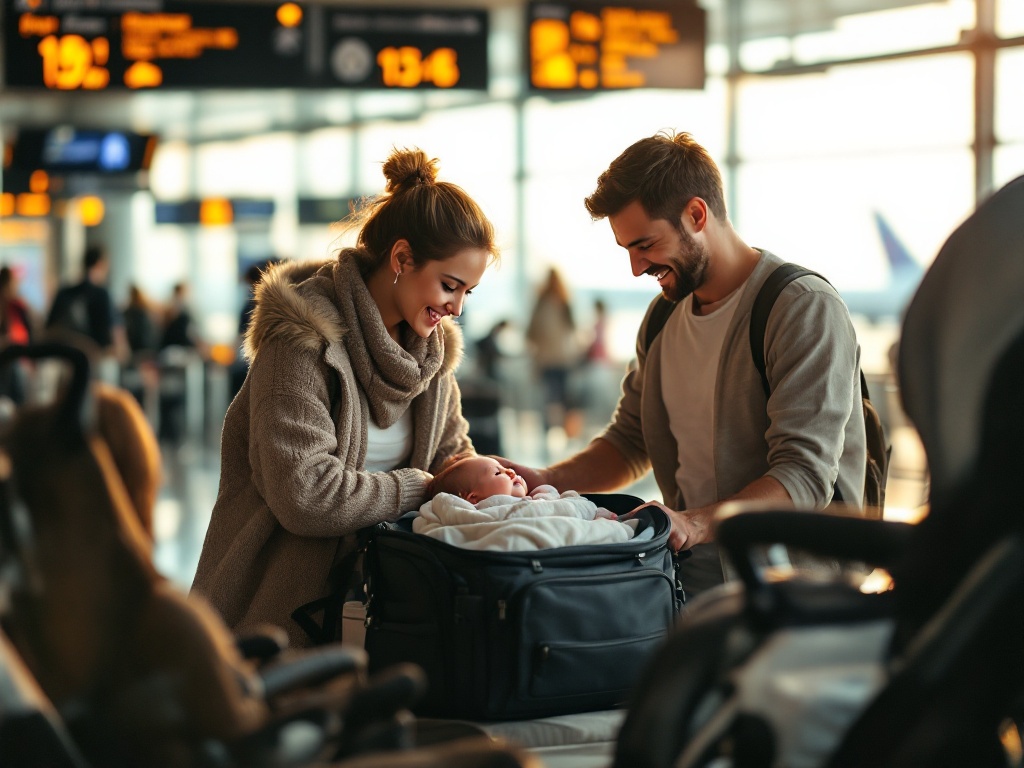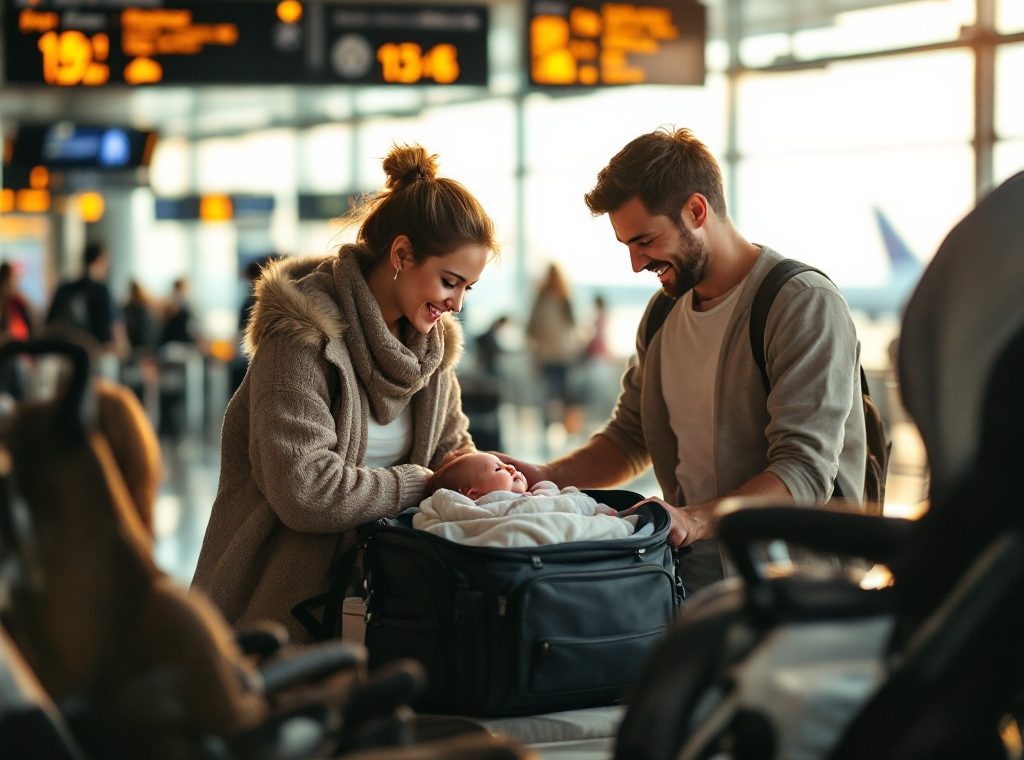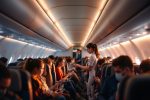Traveling with a Newborn: What Parents Should Know
Planning a trip with your newborn? Traveling with a little one requires careful preparation. This guide provides essential tips, from packing the perfect diaper bag to navigating airline policies and ensuring your baby’s comfort and safety during the flight. Discover how to manage feeding schedules, handle ear pressure during takeoff, and choose the right travel gear. Learn about TSA regulations for breast milk and formula, plus crucial passport information for international travel. Start planning your stress-free family adventure today!
Important information

- Consult your pediatrician before traveling with a newborn, especially if the baby is premature or less than a week old.
- Pack essentials: diapers, wipes, formula/breast milk, bottles, change of clothes, first-aid kit, and comfort items.
- Plan a flexible itinerary with frequent stops for feeding, changing, and soothing. Airline bassinets can be helpful but must be requested in advance.
- An approved car seat is crucial for safety during travel, significantly safer than lap holding. For flights, it’s best to pre-board and choose a window seat.
- TSA regulations allow for reasonable quantities of breast milk and formula beyond the standard liquid restrictions.
Traveling with a Newborn: What Parents Should Know
Traveling with a newborn requires careful planning to ensure your baby’s health and comfort. Before leaving, consult your pediatrician. This is crucial. Consider your transportation method, trip duration, and the destination’s baby-friendliness.
Pack essential items: diapers, feeding supplies, and a first-aid kit.
Plan regular stops for feeding, changing, and soothing your baby.
Consider the destination’s climate and medical care availability.
Don’t forget a favorite toy or blanket for comfort.
A flexible itinerary is essential, as babies have unpredictable schedules. Be prepared to adapt and make extra stops as needed. With careful planning, traveling with your newborn can be a positive experience.
Is It Safe to Travel with a Newborn?
While newborns are generally fit for air travel after a few weeks, experts recommend delaying flights for the first seven days of a baby’s life.
When Can You Start Traveling with a Newborn?
While doctors generally advise against flying with newborns younger than a week old, your pediatrician can offer personalized guidance based on your baby’s specific health needs. Consulting them before making any travel plans is crucial for ensuring your little one’s safety.
Considerations for Premature Babies
Consult your pediatrician before air travel with a premature infant. Their developing lungs present increased risks during flight.
Potential Health Risks During Air Travel
Air travel can expose newborns to illnesses like RSV and the flu, especially due to close proximity with other passengers. Their underdeveloped immune systems make them particularly vulnerable. Therefore, carefully consider the necessity of any planned trips. Weigh the benefits against the potential health risks to your baby. Postponing non-essential travel until your child’s immune system is more robust provides significantly better protection.
Travel Planning for New Parents
Traveling with a newborn requires careful planning. Consider these key factors: destination, accommodation, transportation, and itinerary.
Destination
Choose a destination with easy accessibility, a comfortable climate, and proximity to medical facilities, in case of emergencies. Prioritize relaxing locations with amenities like cribs, changing tables, and kitchen access.
Accommodation
Select family-friendly accommodations that cater to the needs of infants. Look for amenities such as cribs, highchairs, and on-site laundry facilities. Consider the proximity to essential services, such as grocery stores and pharmacies.
Transportation
Carefully consider your mode of transportation. If flying, be prepared for potential delays and ensure you have all necessary baby gear. If driving, plan for frequent stops to feed and change your baby.
Itinerary
Maintain a flexible itinerary that allows for frequent feedings, diaper changes, and naps. Avoid over-scheduling activities and prioritize your baby’s comfort and well-being. Don’t be afraid to take shorter trips, which can be more manageable.
Importance of Careful Preparation
Traveling with a newborn requires careful planning and preparation. Pack essential items like diapers, wipes, formula or breast milk, extra clothes, and any necessary medications. Because delays are common, extra supplies are crucial for unexpected circumstances. A well-stocked diaper bag ensures easy access to these necessities. A comfortable carrier can also simplify your travel experience. Consider these additional tips for a smoother trip:
- Pre-board the flight: Take advantage of pre-boarding options to settle in before other passengers.
- Choose a window seat: This offers more privacy and a surface to lean against.
- Bring a nursing cover or bottle warmer: These items provide comfort and convenience for feeding your baby.
- Pack a few small toys or books: These can help distract and entertain your little one.
- Don’t be afraid to ask for help: Flight attendants are usually happy to assist with warming bottles or providing extra blankets.
Booking a Flight with a Newborn
Traveling with a baby? Most airlines accommodate infants, but confirming their specific policies beforehand is crucial. These policies outline essential details such as age limits, necessary documentation, applicable fees, and seating arrangements. They also specify baggage allowances and acceptable identification for your infant. For detailed information, visit the websites of major airlines like Delta, United, or American.
Understanding Airline Policies and Amenities
Traveling with a newborn can be daunting, but airlines offer several accommodations to make the experience smoother. Most airlines allow free check-in for strollers and car seats, eliminating the hassle of carrying bulky baby gear. Some airlines provide bassinets that attach to the bulkhead, creating a safe and comfortable sleeping space for your baby. However, these bassinets are often limited and assigned on a first-come, first-served basis. Contact the airline in advance to request a bassinet and confirm its availability. Remember to inquire about weight and size restrictions for both checked and carry-on items to ensure a hassle-free journey.
Packing Essentials for Newborn Travel
Traveling with a newborn? Here’s a handy checklist:
- Diapers, wipes, and a changing pad.
- Formula or breast milk, bottles, and a pacifier.
- Extra clothes and blankets.
- A first-aid kit.
- A baby carrier or stroller.
- A travel crib.
- A favorite toy.
- Extra supplies in case of travel delays.
What to Include in a Well-Packed Diaper Bag
Preparing a diaper bag for your newborn can be daunting, but thoughtful planning ensures you’ll have all the essentials.
Diapering Essentials
- pack plenty of diapers and wipes,
- include a changing pad,
- don’t forget diaper rash cream.
Feeding Essentials
- pack formula or breast milk storage bags and bottles,
- consider a nursing cover for discreet breastfeeding.
Burp cloths are indispensable, and a pacifier can work wonders for a fussy little one. A spare outfit is always a good idea.
First-Aid Essentials
- pack antiseptic wipes,
- include a thermometer,
- add infant pain reliever.
Hygiene and Entertainment
Hand sanitizer is essential for maintaining hygiene. Plastic bags neatly contain soiled diapers. As your baby grows, consider adding a few small toys or books to keep them entertained.
With a well-stocked diaper bag, you’re ready for any adventure.
Travel Gear: Strollers, Car Seats, and More
Traveling with a newborn requires careful planning, especially when it comes to essential gear. Here’s what you need:
- Lightweight stroller: a lightweight, easily foldable stroller is key for navigating busy airports.
- Airline-approved car seat: a car seat, approved by most airlines, is crucial for your baby’s safety during the flight. It’s always safer than holding them on your lap.
- Comfortable infant carrier: a comfortable infant carrier provides a secure way to transport your little one, making your trip much smoother.
Ensuring Safety and Comfort During Travel
When you arrive at your hotel, check for potential hazards to ensure your baby’s safety. Use bottled water for baby formula, not tap water. Dress your baby in layers to adapt to changing temperatures. Bringing familiar items, such as a favorite blanket, can help your baby feel more secure. Stick to your baby’s regular feeding and diaper changing schedule. If you are using a car seat, make sure it is airline-approved. Try to avoid crowds and keep your baby close to you. Wash your hands frequently.
Infant Safety Seats vs. Lap Riding
Infant car seats are essential for protecting babies during sudden stops or turbulent conditions. Research shows they offer significantly better protection than holding a child. An approved car seat is the safest way to transport your baby. Lap riding is extremely dangerous and dramatically increases the risk of severe injury or fatality during a sudden stop or crash. Always secure your baby in a car seat while traveling.
Airline Bassinets and Bulkhead Seats
Traveling with an infant? Request a bassinet early. Airlines provide bassinets on a first-come, first-served basis for bulkhead seats. These bassinets attach to the bulkhead wall, offering extra legroom. However, bulkhead seats sometimes lack under-seat storage, requiring you to store carry-on items overhead during takeoff and landing.
Dressing Your Baby for Temperature Changes
Dressing your baby in layers will help them stay comfortable during flights, as cabin temperatures can fluctuate. Start with a bodysuit, then add pants and a sweater. A light jacket is also a good idea. This allows you to easily adjust your baby’s clothing to maintain the ideal temperature for them.
Managing Ear Pain During Takeoff and Landing
Taking off and landing can be challenging for small children due to changes in cabin pressure. Nursing, giving a bottle, or using a pacifier can help relieve ear pressure during ascent and descent. Encouraging your baby to yawn or swallow can also equalize ear pressure, leading to a more comfortable flight for everyone.
Feeding and Caring for a Newborn on the Move
Traveling with a newborn requires careful planning, especially regarding feeding. Maintaining a consistent feeding schedule is vital. Pack enough formula or breast milk, bottles, and a portable sterilizer. Nursing mothers can use nursing covers and find designated nursing areas in airports and rest stops. Store pre-made formula or expressed milk in a cooler with ice packs to maintain its temperature. Strategically plan feeding times around your travel itinerary to minimize disruptions and keep your baby content. Airport security allows reasonable quantities of breast milk and formula, exceeding the standard 3.4-ounce liquid restriction, but check your airline’s specific policies. For international travel, research local regulations and customs rules about baby food and formula.
Maintain a consistent feeding schedule and pack ample formula or breast milk, bottles, and a portable sterilizer.
Nursing mothers can utilize nursing covers and locate designated nursing areas in airports and rest stops.
Store pre-made formula or expressed milk in a cooler with ice packs to maintain the correct temperature.
Plan feeding times strategically around your travel itinerary to minimize disruptions.
Check your airline’s specific policies regarding breast milk and formula, as airport security allows reasonable quantities beyond the standard 3.4-ounce liquid restriction.
Research local regulations and customs rules about baby food and formula for international travel.
Feeding Schedules and Breastfeeding Tips
Traveling with a newborn, especially regarding feeding, requires careful planning. Whether breastfeeding or bottle-feeding, preparation is key for a smooth trip.
Breastfeeding
Breastfeeding provides flexibility, allowing mothers to nurse on demand or follow a schedule. Consider a nursing cover for privacy and locate comfortable nursing areas, including airport lactation rooms. Staying hydrated is crucial, so pack plenty of water.
Bottle-feeding
Bottle-feeding requires packing enough formula, bottles, and cleaning supplies. Pre-portioned formula containers and a portable bottle warmer can simplify the process. Pack extra formula and water to stay hydrated.
TSA Rules for Breast Milk and Formula
Traveling with baby food, formula, or breast milk? The Transportation Security Administration (TSA) regulations allow you to bring more than the standard 3.4-ounce liquid limit for these essential items. You don’t need to fit them in a quart-sized bag, but you must declare them to a TSA officer at the security checkpoint. These items will be screened separately. Ice packs, freezer packs, and bottles are also permitted. Medically necessary liquids, including baby formula and breast milk, are exempt from the 3-1-1 rule for all domestic and international flights.
Additional Considerations for International Travel
For international travel, every U.S. citizen, even infants, needs a valid passport. Parents must apply for their baby’s passport in person.
Travel Vaccines and Immunizations
Breast milk provides initial immunity for newborns through maternal antibodies, as their immune systems are still developing and they are ineligible for most travel vaccines. Consult your pediatrician regarding travel health and safety for your baby, including destination-specific risks and personalized advice.

















